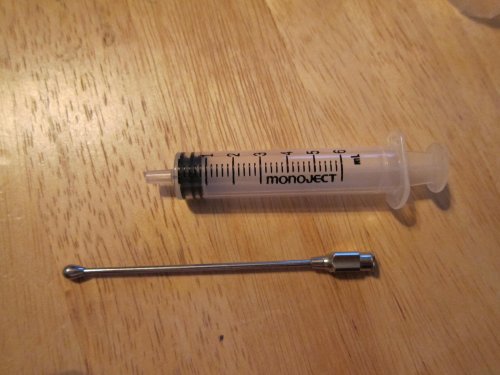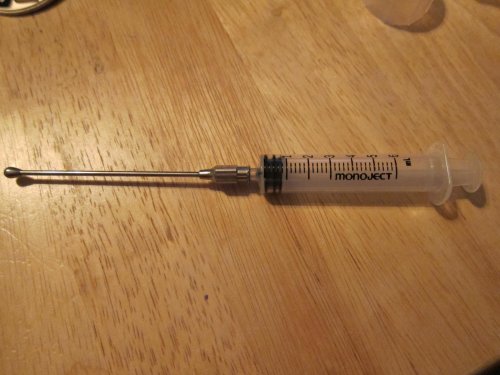absolutbill
Chameleon Enthusiast
Chameleon Info:
Your Chameleon - Ambanja 4 years old, owned since he was 4 months old.
Handling - Used to never due to his bad attitude, however he's been so lethargic the last two days that he doesn't mind being handled.
Feeding - Crickets and superworms - he's fed every other day and has superworms 1 day a week, the remaining feedings are with crickets. He has tried various worms and rejected them. Both feeders are gutloaded with carrots, potatoes, and collard green stems. I just starting adding bug burger on Wednesday.
Supplements - In the beginning of January I switched to Repashy all in 1 Calcium Plus for all cricket feedings. Prior to that he received calcium w/out D3 for all but 1 feeding per week. Calcium with D3 2 times a month, Herptivite 1 time a month and Reptivite 1 time a month.
Watering - I have an automatic mister, mists 3 times a day, 10 minutes a time. First is at 9AM, 2nd is at 1PM, 3rd is at 3PM. Rarely see him drink.
Fecal Description - He has never been tested for parasites, fecals tend toward orange tint, despite all the mistings.
History - The only thing he's ever had wrong was a Vitamin A deficiency about 3 years ago. After learning from the members here I self-treated him and he was fine.
Cage Info:
Cage Type - 24x24x48 screen.
Lighting - ReptiGlo 5.0 24". I change the bulb every 6 months, most recent was yesterday. Also there's a basking bulb. Lights are on a timer - on at 8AM, off at 7PM for the winter months, extended to a 12 hour schedule in the summer.
Temperature - His basking spot was at 80, I just changed the bulb to increase it to 85. The lowest is 75. I use a temp gun.
Humidity - Humidity ranges from 75-80% during misting to 50% when completely dry. I have a portable digital guage that I can move between my cages. All humidity comes from misting and having live plants.
Plants - Yes, 2 live cane plants
Placement - The cage is in the corner of our addition/reptile room. It's blocked by an open French door, when needed, and has walls on 2 sides of it. The cage sits on a utility sink, so the top of the cage is about 7 feet from the floor.
Location - Naples, FL
Current Problem - Kibi has been towards the back of his cage over the past few days, however I chalked that up to being grumpy. His appetite has also been off a bit, though I have seen him eating. When I went to feed him yesterday he was in the front of the cage and was red (usual coloring is green with purple barring). His eyes were closed and VERY sunken in. I immediately put him in the shower with me for 40 minutes, then wrapped him in a fleece and held him against me, but his eyes were still closed.
We did another shower for 30 minutes before I left for work yesterday. Today I just showered him for 1 hour. While in there today I used an eye dropper to drip water into his mouth and he seemed to take more than he had yesterday. I tried offering a mealworm (the smallest feeder I have available). He would not open his mouth to take it. His eyes are mostly closed - his left eye seems permanately closed at this point.
The vet couldn't fit me in yesterday so we have an appointment for Monday morning. Right now I have him wrapped in a heat pack and my husband is holding him to try to warm him up after his shower before putting him into his cage - the lights are off for the night and I want him dry and warm before putting him to bed.
I know hornworms are great for rehydration, but are there any other methods I can use tomorrow until we can see the vet? My husband can shower him tomorrow a couple of times, and I'll have him try with small feeders as well as the dripper. I'm going to order some hornworms but it'll take a few days before they arrive.
Please, I am willing to do anything to help him - I just don't know what else to try. I have him in his cage each night, but have rigged up a cap holder upside down to act as a basket in case he falls and have a towel under that as a back up. His grip still seems fairly good - but from time to time he tries to grab a front leg with his back leg. I think this is more from having his eyes closed, and not MBD since he's always been suplimented.
Michelle
Your Chameleon - Ambanja 4 years old, owned since he was 4 months old.
Handling - Used to never due to his bad attitude, however he's been so lethargic the last two days that he doesn't mind being handled.
Feeding - Crickets and superworms - he's fed every other day and has superworms 1 day a week, the remaining feedings are with crickets. He has tried various worms and rejected them. Both feeders are gutloaded with carrots, potatoes, and collard green stems. I just starting adding bug burger on Wednesday.
Supplements - In the beginning of January I switched to Repashy all in 1 Calcium Plus for all cricket feedings. Prior to that he received calcium w/out D3 for all but 1 feeding per week. Calcium with D3 2 times a month, Herptivite 1 time a month and Reptivite 1 time a month.
Watering - I have an automatic mister, mists 3 times a day, 10 minutes a time. First is at 9AM, 2nd is at 1PM, 3rd is at 3PM. Rarely see him drink.
Fecal Description - He has never been tested for parasites, fecals tend toward orange tint, despite all the mistings.
History - The only thing he's ever had wrong was a Vitamin A deficiency about 3 years ago. After learning from the members here I self-treated him and he was fine.
Cage Info:
Cage Type - 24x24x48 screen.
Lighting - ReptiGlo 5.0 24". I change the bulb every 6 months, most recent was yesterday. Also there's a basking bulb. Lights are on a timer - on at 8AM, off at 7PM for the winter months, extended to a 12 hour schedule in the summer.
Temperature - His basking spot was at 80, I just changed the bulb to increase it to 85. The lowest is 75. I use a temp gun.
Humidity - Humidity ranges from 75-80% during misting to 50% when completely dry. I have a portable digital guage that I can move between my cages. All humidity comes from misting and having live plants.
Plants - Yes, 2 live cane plants
Placement - The cage is in the corner of our addition/reptile room. It's blocked by an open French door, when needed, and has walls on 2 sides of it. The cage sits on a utility sink, so the top of the cage is about 7 feet from the floor.
Location - Naples, FL
Current Problem - Kibi has been towards the back of his cage over the past few days, however I chalked that up to being grumpy. His appetite has also been off a bit, though I have seen him eating. When I went to feed him yesterday he was in the front of the cage and was red (usual coloring is green with purple barring). His eyes were closed and VERY sunken in. I immediately put him in the shower with me for 40 minutes, then wrapped him in a fleece and held him against me, but his eyes were still closed.
We did another shower for 30 minutes before I left for work yesterday. Today I just showered him for 1 hour. While in there today I used an eye dropper to drip water into his mouth and he seemed to take more than he had yesterday. I tried offering a mealworm (the smallest feeder I have available). He would not open his mouth to take it. His eyes are mostly closed - his left eye seems permanately closed at this point.
The vet couldn't fit me in yesterday so we have an appointment for Monday morning. Right now I have him wrapped in a heat pack and my husband is holding him to try to warm him up after his shower before putting him into his cage - the lights are off for the night and I want him dry and warm before putting him to bed.
I know hornworms are great for rehydration, but are there any other methods I can use tomorrow until we can see the vet? My husband can shower him tomorrow a couple of times, and I'll have him try with small feeders as well as the dripper. I'm going to order some hornworms but it'll take a few days before they arrive.
Please, I am willing to do anything to help him - I just don't know what else to try. I have him in his cage each night, but have rigged up a cap holder upside down to act as a basket in case he falls and have a towel under that as a back up. His grip still seems fairly good - but from time to time he tries to grab a front leg with his back leg. I think this is more from having his eyes closed, and not MBD since he's always been suplimented.
Michelle







